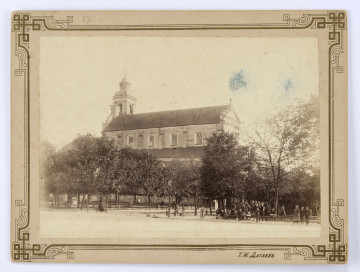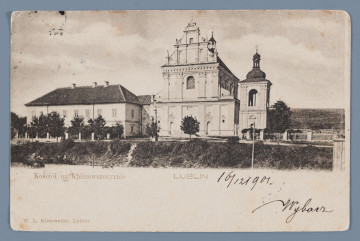
Bernardine Church
1890 — 1910
National Museum in Lublin
Part of the collection: Photographs of Lublin
The Monastery of Discalced Carmelites in Świętoduska Street in Lublin was initially the seat of Carmelite nuns, and later of Discalced Carmelites. Founded in the first half of the 17th century by Katarzyna Ligęzina, née Kretka, it stood on the site of a Calvinist congregation erected for Rafał Leszczyński by Jakub Balin. The monks came here in the early nineteenth century, after the fire of their own seat on Krakowskie Przedmiescie Street (now the Town Hall is located there). The monastery building adjoins the Church of St Joseph, the Spouse of the Blessed Virgin Mary.
The builder of the temple, bearing features of the Lublin Renaissance, was Jakub Tremanzel. In the 1940s, an annex called the Chaplain's House was built in the neighbourhood, at 16 Świętoduska Street. The entrance to the church leads from the street through the porch. At the beginning of the 20th century it was decorated with a Neo-Renaissance attic designed by Stefan Szyller. At that time also, the top of the church was decorated with a polychrome by Władysław Barwicki with images of Our Lady of the Scapular and the patron saints of the order - St Joseph, St John of the Cross and St Teresa of Jesus (renovated in sgraffito technique by Maria Berezowska in 1950). In the north-west corner of the presbytery rises a slender tower visible from the street, called a minaret.
The Carmelite Order was abolished after the fall of the January Uprising. In 1898-1907, the Lublin monastery was turned into a prison. During World War I, a blacksmith's shop, an infirmary and a police station were located there. In 1918, the Carmelites recovered some of the rooms. The remaining rooms came under the administration of the army. The main part of the monastery housed a military detention centre. During the Second World War a hospital and a prison were set up here. After 1944, the post-convent premises housed the NKVD detention centre. The monks regained all the buildings only in 1988.
Dimensions
cały obiekt: height: 15,3 cm, width: 20,4 cm
Object type
photography
Technique
sepia
Material
paper, cardboard, ink, pencil
Creation time / dating
Creation / finding place
Owner
The National Museum in Lublin
Identification number
Location / status

1890 — 1910
National Museum in Lublin

1916 — 1917
National Museum in Lublin

1899 — 1901
National Museum in Lublin
DISCOVER this TOPIC
Museum of King Jan III's Palace at Wilanów
DISCOVER this PATH
Educational path